
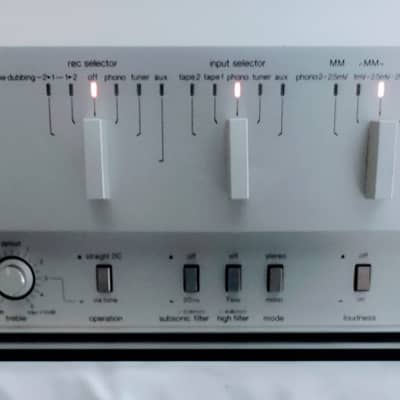
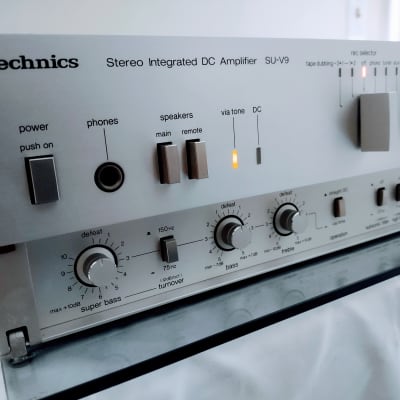
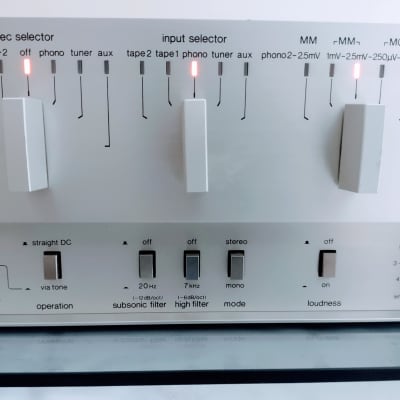
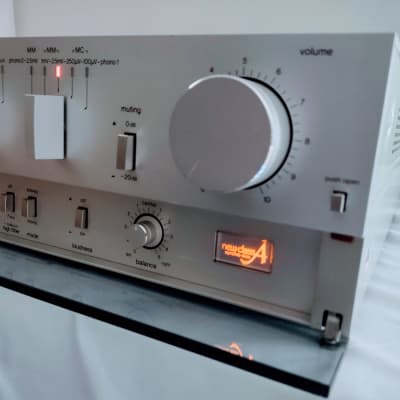
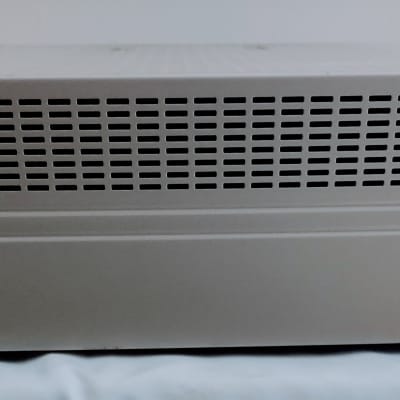
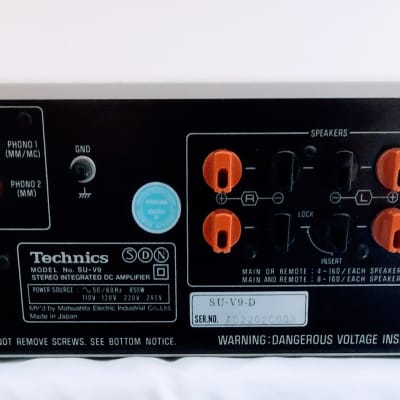
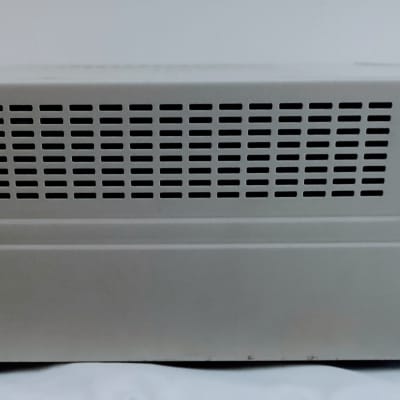
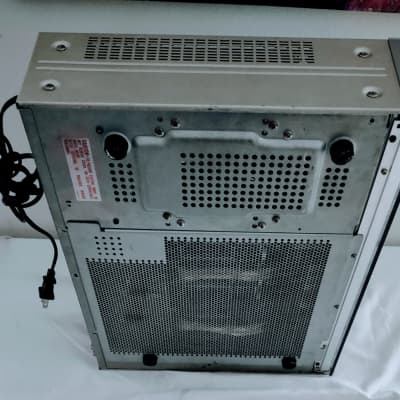
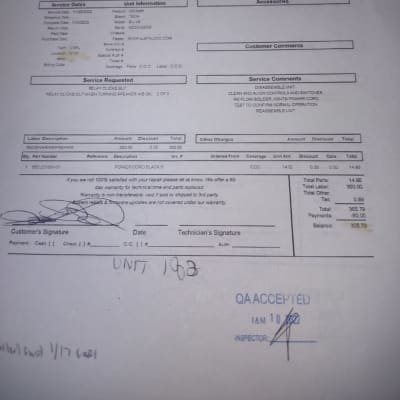
Monster Technics SU-V9, 120 WPC, professionally serviced. It had the controls cleaned, solder reflowed where needed and has a new power cord. The smoked front glass door is often broken on these units, in perfect condition here. It leans to a more clinical sound rather than the slightly warm sounding units of the 70's. It has a huge damping factor of 80 where most amps have 30-50. This makes for a large amount of bass being available should you want it. The Super Bass controls are another notable feature, read below for details.
Hifiengine user thetoolguydave writes:
"i purchased one of these new in the 80's for $920 and still have it today. Even though i was told it would not do the job I used it for many years in my disc jockey service to power 2 pairs of Sound Dynamics 1500 concert monitors and a 2 pair of Audio Sphere research 18L monitors(stacked SD on top of the AR). I ran it hard and long without it ever failing on me. The most that ever happened was the overload protection might activate if i was asking it to do more than it was designed to do, usually from trying to run a speaker load lower than 4ohms to maximize its power output. It surprised a lot of people to look at the grills of these speakers and see that you could visibly see the woofer rings from where they had been striking the grills. Unheard of from a mere 120 RMS per channel..."
HiFi Review:
"There are some products whose use gives us pleasure beyond what we might rationally expect from their quality, fine though it may be. When we encounter such a model, we usually find it as hard to contain our irrational enthusiasm as to explain its source. The Technics SU-V9 is a case in point: There's no doubt that it is a fine integrated amplifier, typical of Technics at its best, but that says nothing about its special appeal-its charisma."
The first thing you'll probably notice about the SU-V9 is that the "esoteric" controls are arrayed along the bottom of the front panel behind a smoked, transparent flip-down door. This arrangement inhibits careless use of these special-purpose adjustments without hiding them beyond reach of a quick visual check. The idea struck us as a little gimmicky at first (and the fact that the door is motor-driven still does), but we quickly came to the conclusion that this compromise between clutter and closet audiophilia is eminently functional.
The least familiar of the features behind the door is what Technics calls the super-bass tone control. It is designed to give speakers-particularly the increasingly popular minispeakers-an extra kick at the bottom end, where response otherwise begins to roll off. To match its operation to varying rolloff characteristics, there is a choice of two turnover frequencies: 150 and 75 Hz, these being the points at which the response is up by 3 dB at the maximum boost setting of the rotary control. The control itself is calibrated from 0 to 10, with the numbers corresponding reasonably closely to the boost (in dB) at 20 Hz. (Unlike some deep-bass boosts, this one shelves toward the bottom end of the audio range, rather than dropping off abruptly.)
The control's audible effect will vary considerably, according to the loudspeakers used, their positioning, and the setting of the control. Misused, it could create an unnatural heaviness or, in some cases, overload and distortion resulting from boosted infrasonics. With most "bookshelf" speakers, however, moderate boost at the 75-Hz posifion may improve low-end solidity and authority on some material.
Although the Superbass control doesn't seem to have any protective filtering of its own at the very bottom of its range, there is a switchable infrasonic filter, whose slope (12 dB per octave) and turnover frequency (25 Hz) are typical of effective designs of this sort. The relative gentleness of the high filter (6 dB per octave above 7.3 kHz) makes it less effective, though it will ameliorate minor background hiss. The tone controls both have shelving response characteristics, with maxima of about ±10 dB available in the treble and ±7 dB in the bass. The latter reaches a little higher into the midrange than is usual; this, plus the rather restricted adjustment range, is no doubt dictated by the presence of the deep-bass control, since the two can be used together to shape the bass in ways that are well beyond the capability of conventional controls. (The manual, which is excellent on basics, is skimpy on such fine points.) The tone-control defeat switch restores "linear DC" operation (with no capacitors in the signal path). The loudness causes the response to begin rising below about 1 kHz to a maximum of +7 dB below 100 Hz and is unaffected by the volume setting within Diversified Science Laboratories' test range (±10 dB re the IHF/EIA standard volume setting for test purposes), making it identical in effect to the bass control at maximum boost.
There are three selector knobs, so to speak, each with an array of LEDs to indicate its setting (though the knobs themselves are shaped so as to leave little doubt on this score). The first selects recording output and includes an off (to prevent nonlinear loading of the main signal path, which can occur with some recorders when they're shut off) as well as positions for dubbing in both directions with two recorders. The second knob is the main listening selector and includes monitoring for the two decks. The third addresses the phono section only and provides two sensitivity settings for moving-coil and two for fixed-coil pickups on Phono 1. (Phono 2 is permanently set for standard, high-output fixed-coil pickups.)
Technics' labeling of these settings can be somewhat confusing, however, because of variations in the way manufacturers specify the sensitivities of pickup cartridges themselves. (The owner's manual speaks only of a "rating," without specifying what kind.) The settings aren't critical, however, and the best advice we can offer is that you use whichever delivers a listening level closest to that of the tuner or other inputs. The "2.5-mV" setting works very nicely with pickups of medium to high output (including most of the popular moving-magnet types). The '' 1,0-mV" setting does equally well by fixed-coil models of medium to low output and by moving-coil designs of very high output (those intended for use without a head amp or transformer). And one or both of the moving-coil settings should be at least adequate with the remaining moving-coil models.
The power section uses Technics' New Class A circuitry. Although we're exceedingly pleased by what we hear, we don't know whether any special "listenability" is contributed by the circuit configuration. In terms of conventional measurements, the results are much what one would expect from any first-rate amplifier: There are no distortion products above 0.01% at the 0-dBW (1-watt) test level, and none above that figure, even at full power, until the very high end of the frequency range is reached.
Power output: 120 watts per channel into 8 ohms (stereo)
Frequency response: 20Hz to 20kHz
Total harmonic distortion: 0.003%
Damping factor: 80
Input sensitivity: 0.25mV (MC), 2.5mV (MM), 150mV (line)
Signal to noise ratio: 71dB (MC), 79dB (MM), 91dB (line)
Channel separation: 55dB (line)
Output: 150mV (line)
Speaker load impedance: 4 ohms to 16 ohms
Reverb Buyer Protection
Reverb has your back if your item is lost, damaged, or doesn't match its description. Simply report any issues within 7 days and we'll help you get a full refund.Learn more about Reverb Buyer Protection.
| Listed | 8 months ago |
| Condition | Very Good (Used) Very Good items may show a few slight marks or scratches but are fully functional and in overall great shape.Learn more |
| Brand | |
| Model |
|
| Finish |
|
| Categories | |
| Year |
|
| Made In |
|

